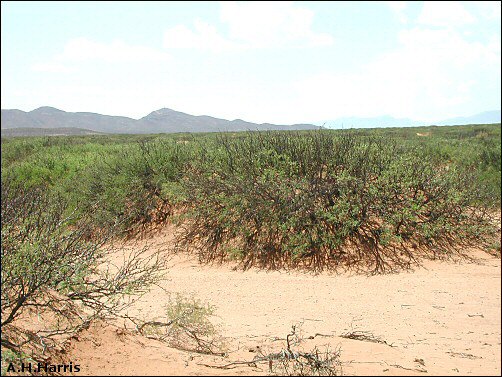

Often it's difficult to visualize our desert as it was several centuries ago. Not only natural changes in climate and vegetation, but human-caused differences abound. Well into the 19th century, many of our desert basins in the northern regions were in desert grassland. Black grama and other grasses were dominant, with shrubs relatively rare.
Changes after the middle of the 1800s have turned many of these areas
into shrublands, with few grasses surviving. In many of the sandy areas, what used to
be relatively flat, gently sloping portions of the desert basins now support a sea of
hummocks. As grasses became rare, shrubs such as mesquite took over. With the loss of
the soil-holding capacity of grasses, sand blew about freely except around the base of
a shrub. The force of the wind broken, the sand built up around the lower parts of the
shrub, slowly burying it; mesquite, however, usually is able to grow fast enough to
keep its uppermost branches above the sand. The result? Mesquite branches emerging from
a high pile of sand—the mesquite hummock.

Contributor: Arthur H. Harris, Laboratory for Environmental Biology, Centennial Museum, University of Texas at El Paso.
Desert Diary is a joint production of the Centennial Museum and KTEP National Public Radio at the University of Texas at El Paso.

Mesquite hummocks, Tularosa Basin, August 2004. Photograph by A.H. Harris.